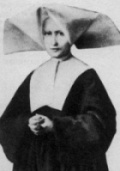St Catherine Laboure

Nun and visionary. Founder of the devotion of the Miraculous Medal. Catherine came from a large farming family near Dijon in France. Born in 1806, she looked after her widowed father and later worked as a waitress in her uncle's cafe in Paris, before joining the Sisters of Charity at the age of 14.
She lived in the community in Reuilly, caring for the elderly in a rest home and tending chickens. Her superiors wrote that she was a 'quiet and dull' person. Until her last years, few people realised that she led an extraordinary inner life.
Through a series of dreams and visions, she accurately foresaw many historical events in France. In one dream she saw a picture of Mary standing on a globe with shafts of light coming from her hands with the inscription underneath reading: 'Mary conceived without sin pray for us who have recourse to thee.' On the reverse side was a capital M with the cross above and two hearts below.
Catherine believed she was ordered to have this produced as a medal. She spoke with her superiors and, in 1832, the archbishop allowed 1,500 to be minted. Later an account of the medal's origins was published. A canonical review in 1836 declared them authentic.
In 1842 a Jewish man from Alsace, Alphonsus Ratisbone, inspired by the devotion to the medal, became a Christian and founded the Fathers and Sisters of Sion. From that time onwards, the devotion to the Miraculous Medal spread around the world.
Catherine died on 31 December 1876. Her body remains incorrupt in the convent chapel at Rue de Bac, Paris. She was canonised in 1947.












